Our plant-based Low FODMAP Baja Tempeh Taco Salad features spicy, seasoned tempeh as the star of the show, but it doesn’t stop there! In addition to cumin, cayenne, smoked paprika and oregano tempered with maple syrup and soy sauce we have a fresh crunchy salad with arugula, cilantro, cabbage and pepitas. More texture and flavor from nutritional yeast and tortilla chips top everything off with a garlicky lime dressing.
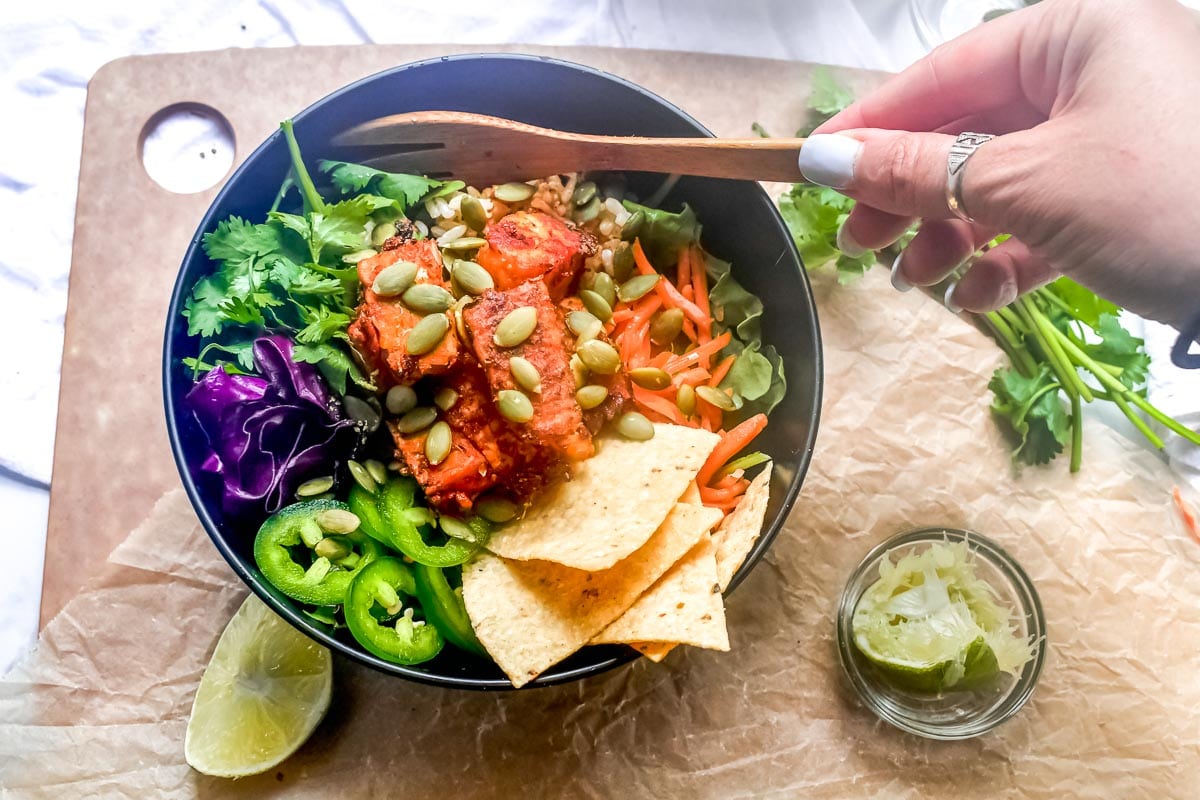
Think You Don’t Like Tempeh?
I’m going to keep it real with all of you – when I first encountered tempeh, I did it all wrong. I made some classic mistakes that put me off tempeh for years!
My big mistake: I tried it raw. Now some people enjoy it that way, and that is perfectly valid! But I quickly discovered I was not one of those people. I found it to be slightly bitter, chewy and bland.
Turns out, I did it all wrong! With a couple of simple additional steps in my tempeh recipes, I discovered that this ingredient was exactly the kind of plant-based, low FODMAP protein swap I had been looking for.
This Low FODMAP Baja Tempeh Taco Salad is a zesty, refreshing, and nutritionally balanced option for the plant-based FODMAPer. And pro tip: if you prep the tempeh in advance, you can cut a full 25 minutes off of this already-simple recipe, to make it a perfect weekday lunch!
To back it up a bit, tempeh is a fermented product made from soybeans. You can typically find it in the produce section of the grocery store, right next to the tofu. And, Monash University has lab tested tempeh and it is low FODMAP in 100 g portions, which is quite generous.
Though they are both made of soybeans, a major difference between tofu and tempeh is the texture. While tofu tends to be a bit softer, tempeh is a bit chewier and lends to a meatier type of mouthfeel. Check out our vegetarian tempeh chili! In that recipe it is ground and has a “ground meat” texture. Our Low FODMAP Gado-Gado is another low FODMAP recipe featuring tempeh for you to try.
Another key difference is the cooking process required for tofu versus tempeh. Tofu can be marinated and cooked on either a frying pan or in the oven, without any additional work. Some also like to have it plain and uncooked, which is also an option.
With tempeh, the preferred cooked method for most – and the important tidbit of information that I was missing prior to experimenting with it in my cooking! – is that tempeh is best when steamed, prior to cooking.
Steaming removes some of the bitterness I mentioned up top, and also makes the tempeh a bit softer and more porous. Altogether, this makes the tempeh take on a more neutral flavor that can easily absorb whatever your favorite low FODMAP marinade is, in addition to a softer texture!
So, let’s dive right in. I’m about to share the details on how to make delicious, Instagram-worthy, protein-rich, meaty-textured tempeh without the faux-pas I made, using this Baja Tempeh Taco Salad as our example.
There are corn chips in this salad, and we bet you are wondering if they are low FODMAP? Yes, they are, as are many corn products, from fresh to cornmeal.
Please review our article, Is Corn Low FODMAP? for a deeper dive into this versatile ingredient.
INGREDIENTS
Here is a pic of what tempeh looks like fresh out of the package with some of the flavor-packed ingredients.
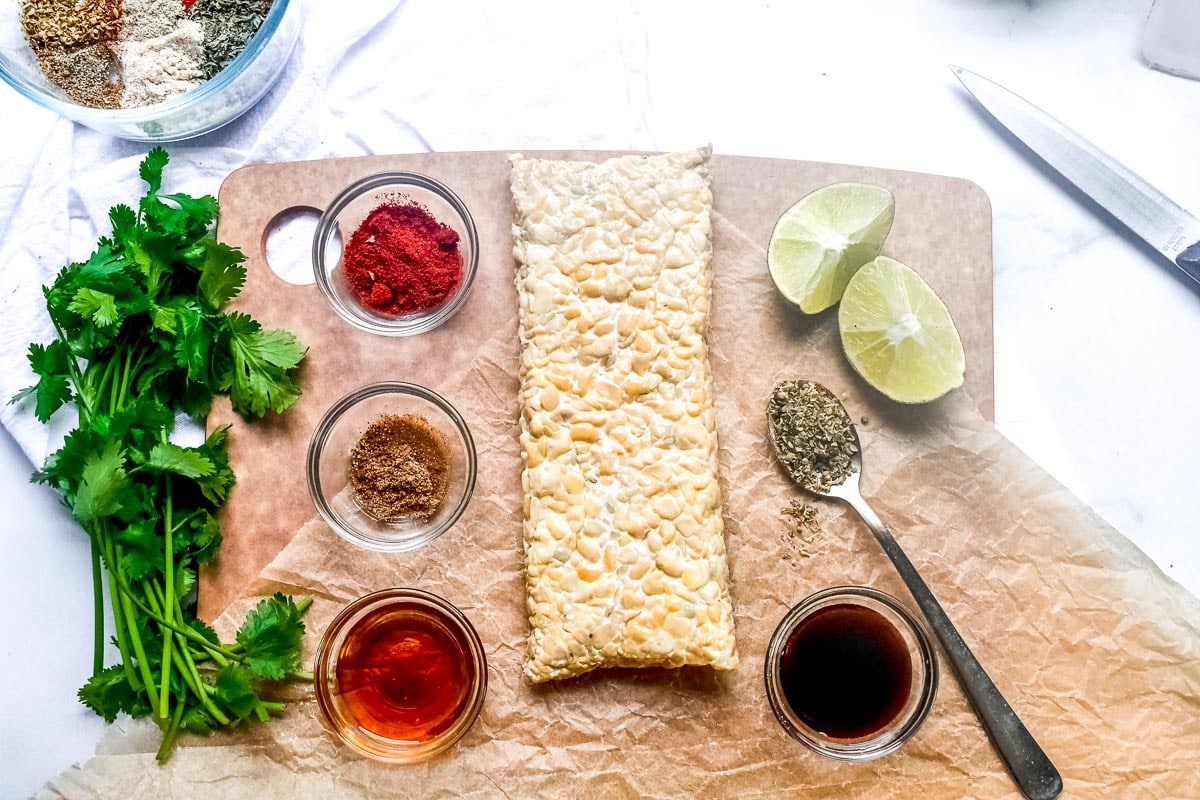
How To Make Our Baja Tempeh Taco Salad
For the Tempeh: Preheat your oven to 375°F (190°C). Have ready a parchment lined half-sheet pan.
Add about 1-inch (2.5 cm) of water to a medium saucepan fitted with a steamer insert and bring to a boil.
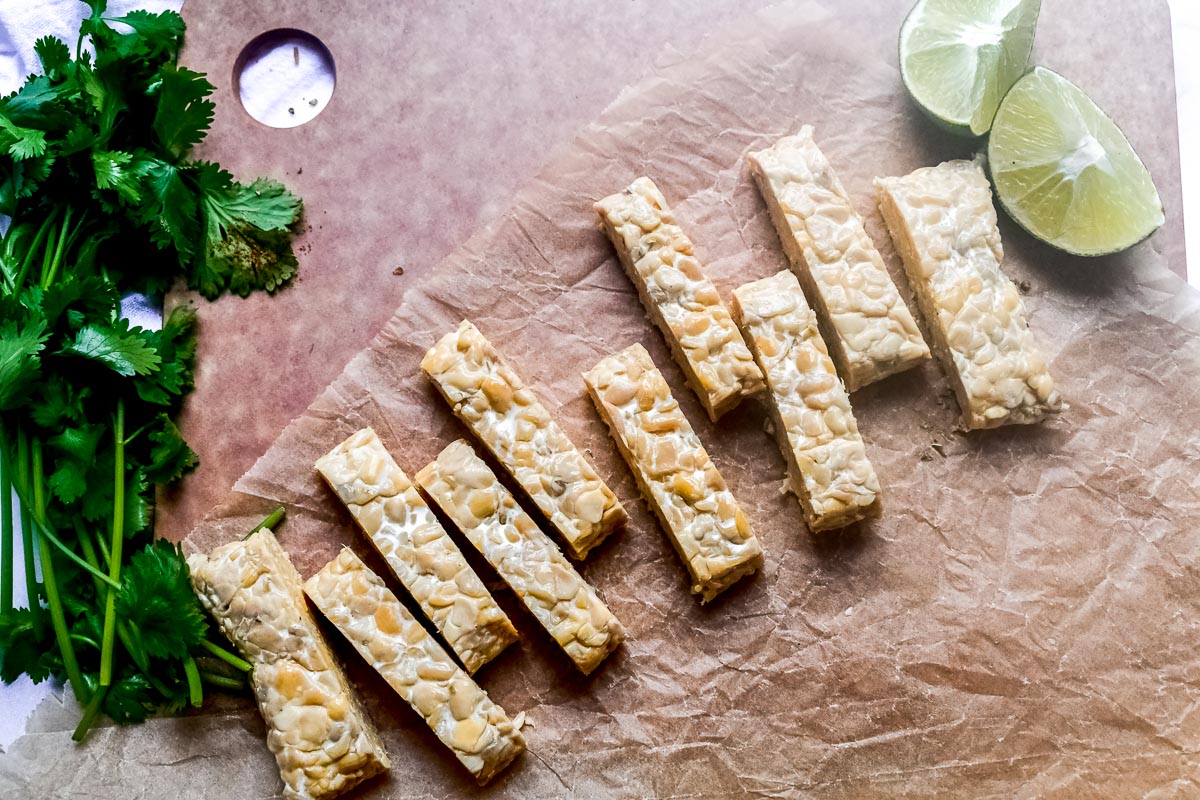
While your water is coming to a boil, prepare your tempeh by removing it from the packaging and chop into 1-inch (2.5 cm) cubes.
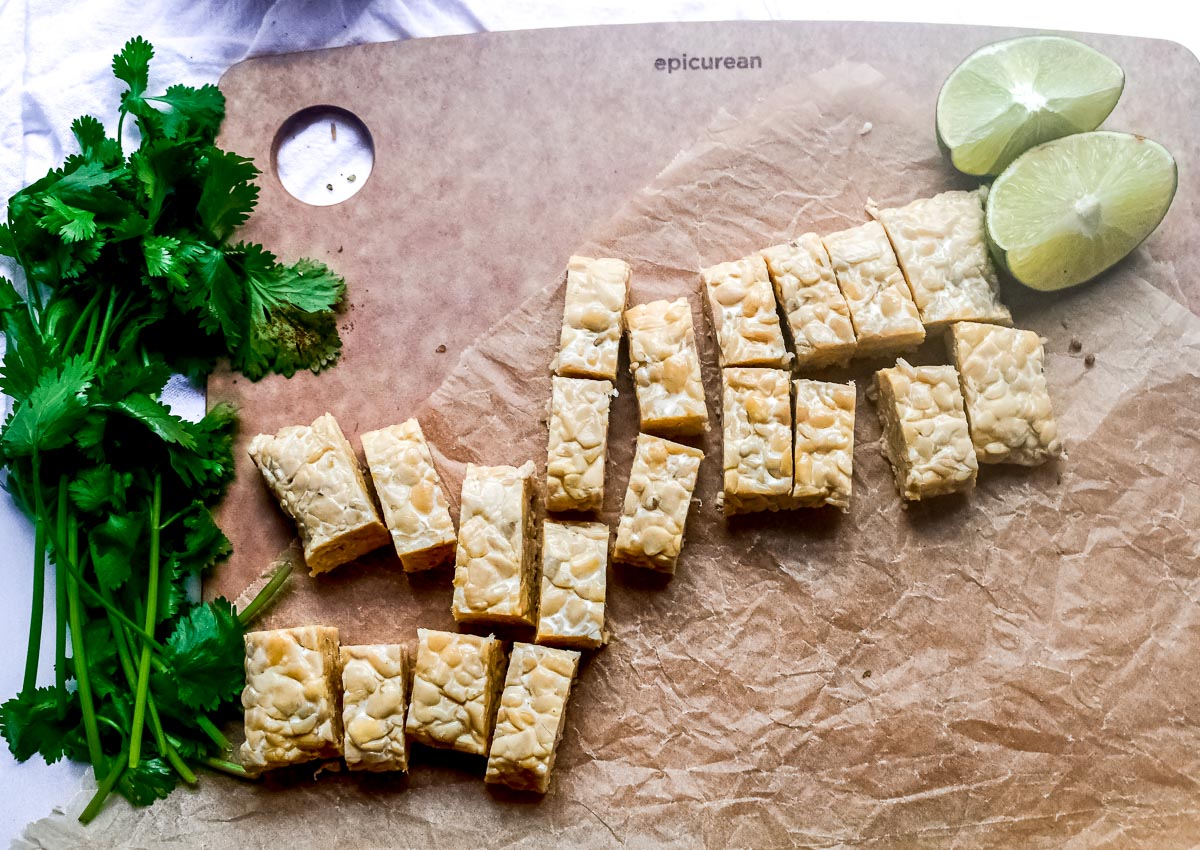
Once your water is boiling, add your tempeh to the steamer and cover. Allow the tempeh to steam for 15 minutes.
While the tempeh steams, prep your smokey taco marinade! Combine the lime juice, cumin, soy sauce, maple syrup, oregano, smoked paprika, red pepper flakes, cayenne and salt in a medium bowl and mix well.
Remove tempeh from the steamer. You can steam and bake the tempeh ahead of time, if you like. Refrigerate in an airtight container for up to 2 days and bring to room temperature before proceeding.
Toss tempeh in a small bowl with oil. Transfer the tempeh onto reserved half-sheet pan, and make sure that the pieces are evenly spaced. Bake tempeh in the oven for 15 minutes or until golden brown, flipping over once during baking.
Add tempeh fresh from the oven to the spicy taco marinade bowl and toss to coat.
For the Dressing & Salad: As the tempeh bakes, whisk the dressing oil and lime juice together and season with salt and pepper – or for a fancier low FODMAP salad dressing try our Low FODMAP Green Goddess Dressing.
Start building your salad: Begin by dividing arugula and shredded carrots in two bowls.
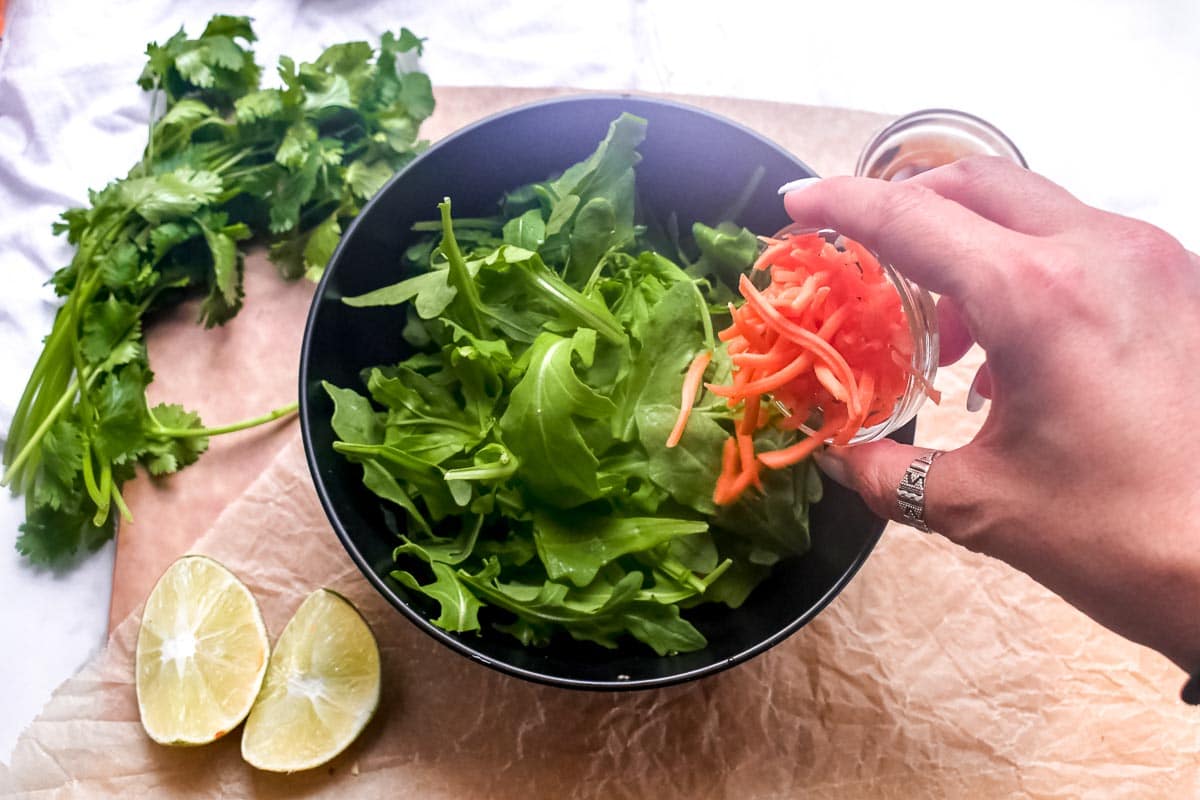
Add rice – or even quinoa. Warm or room temperature is fine.
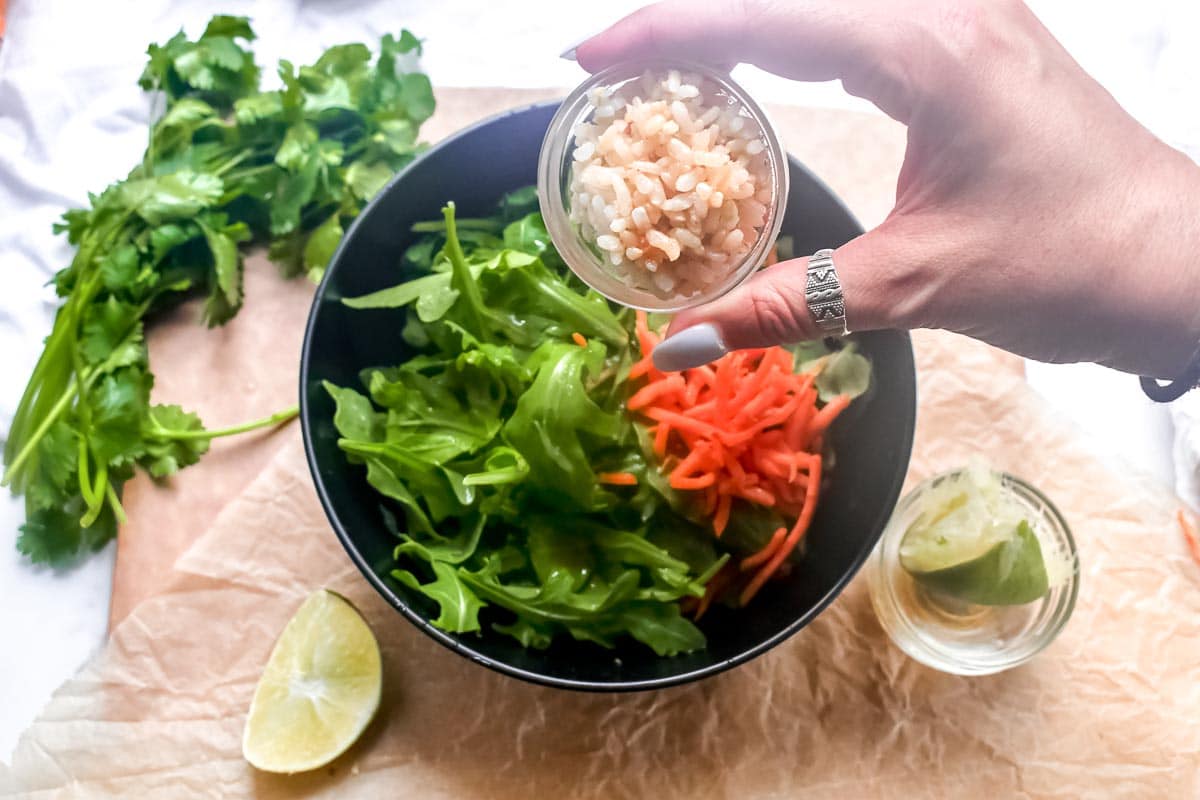
Keep going! Cabbage, cilantro – and corn tortilla chips for texture and flavor.
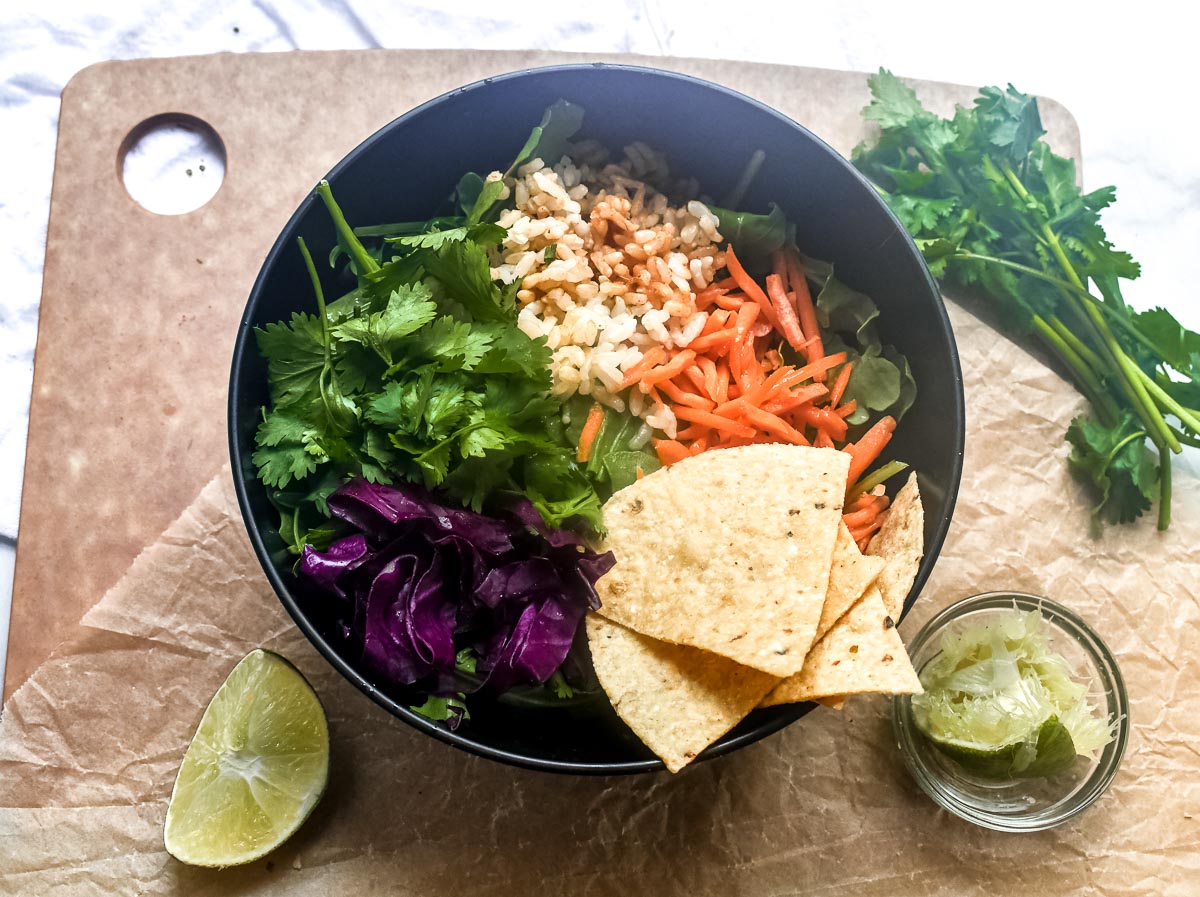
Nutritional yeast adds a cheese flavor and nutrition. It contains protein, B vitamins 1, 2, 3, 6 and 12 as well as potassium, calcium and iron. Fiber, too! Some brands are also fortified with folic acid.
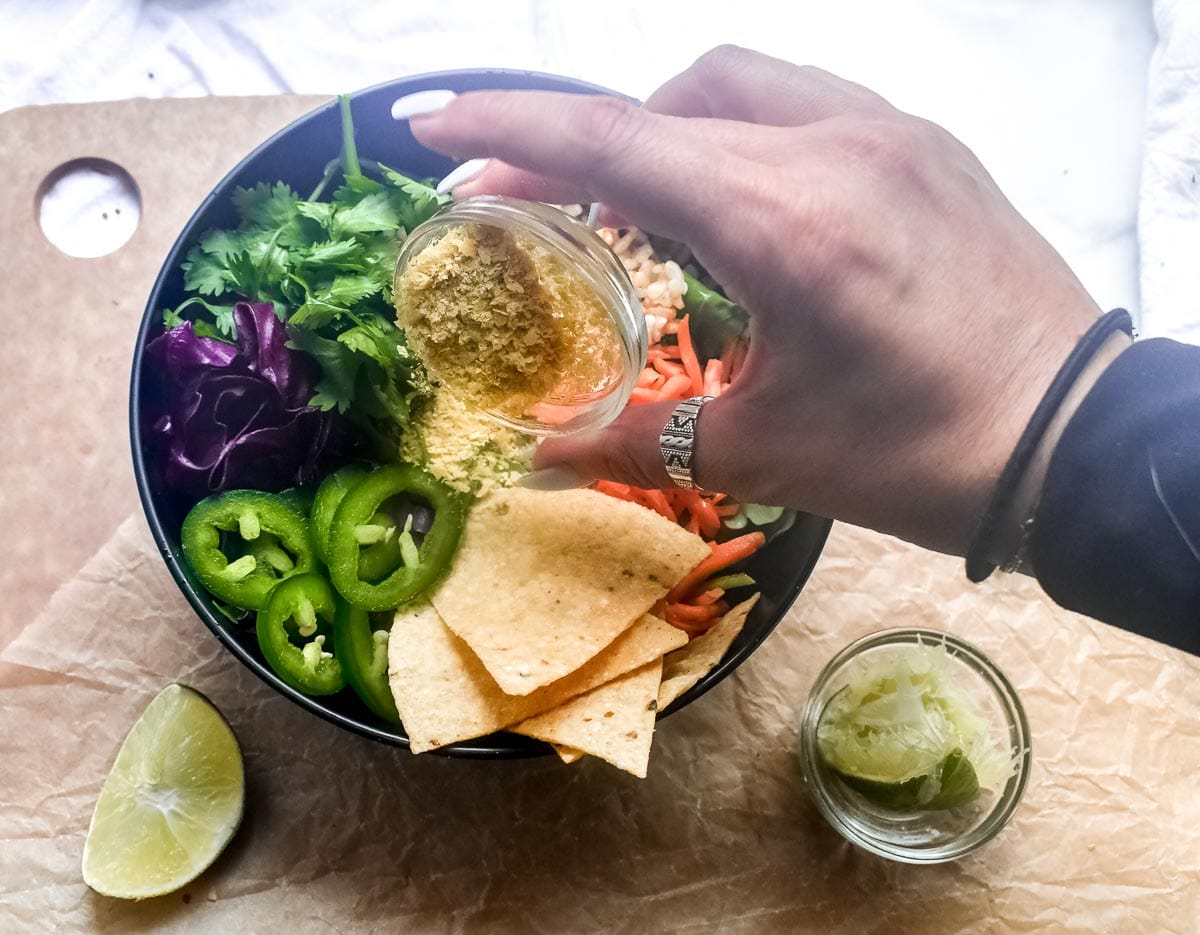
Now add jalapeños – as many or as few slices as you like – and your marinated and coated cooked tempeh.
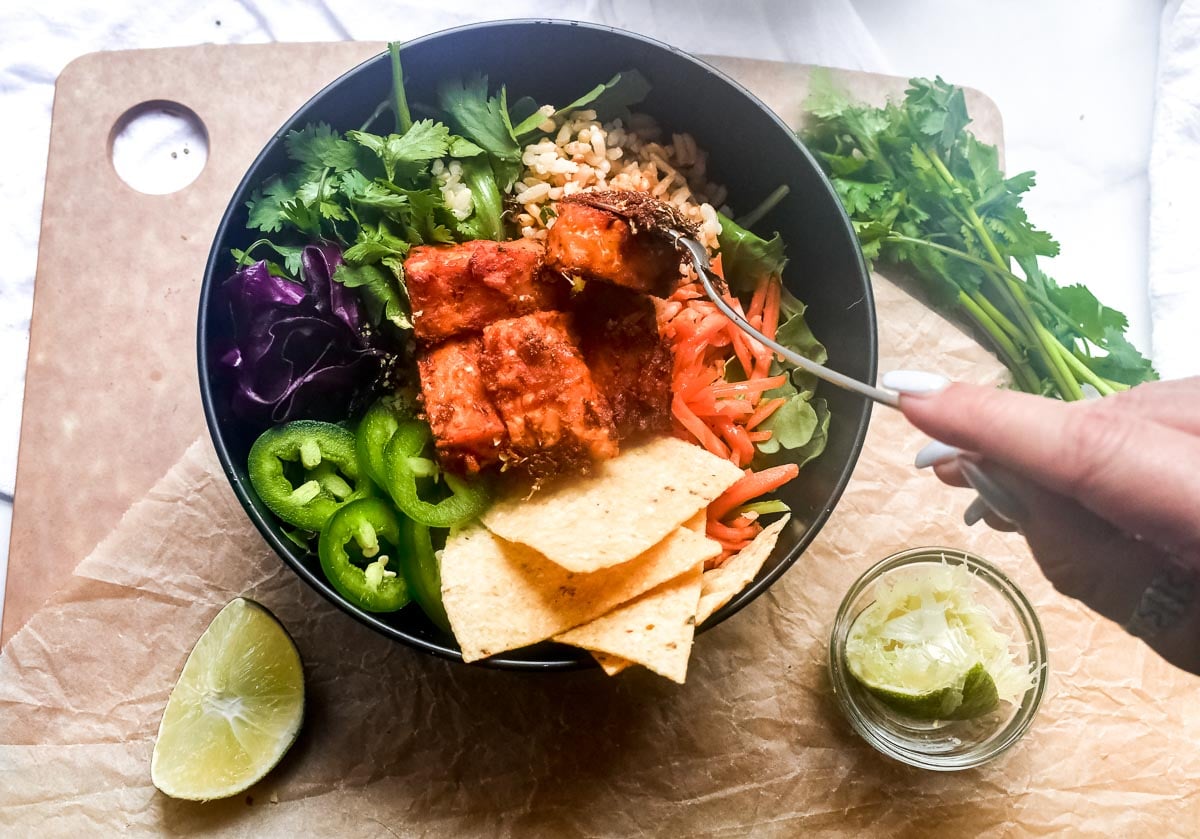
Pepitas (pumpkin seeds) add loads of crunch.
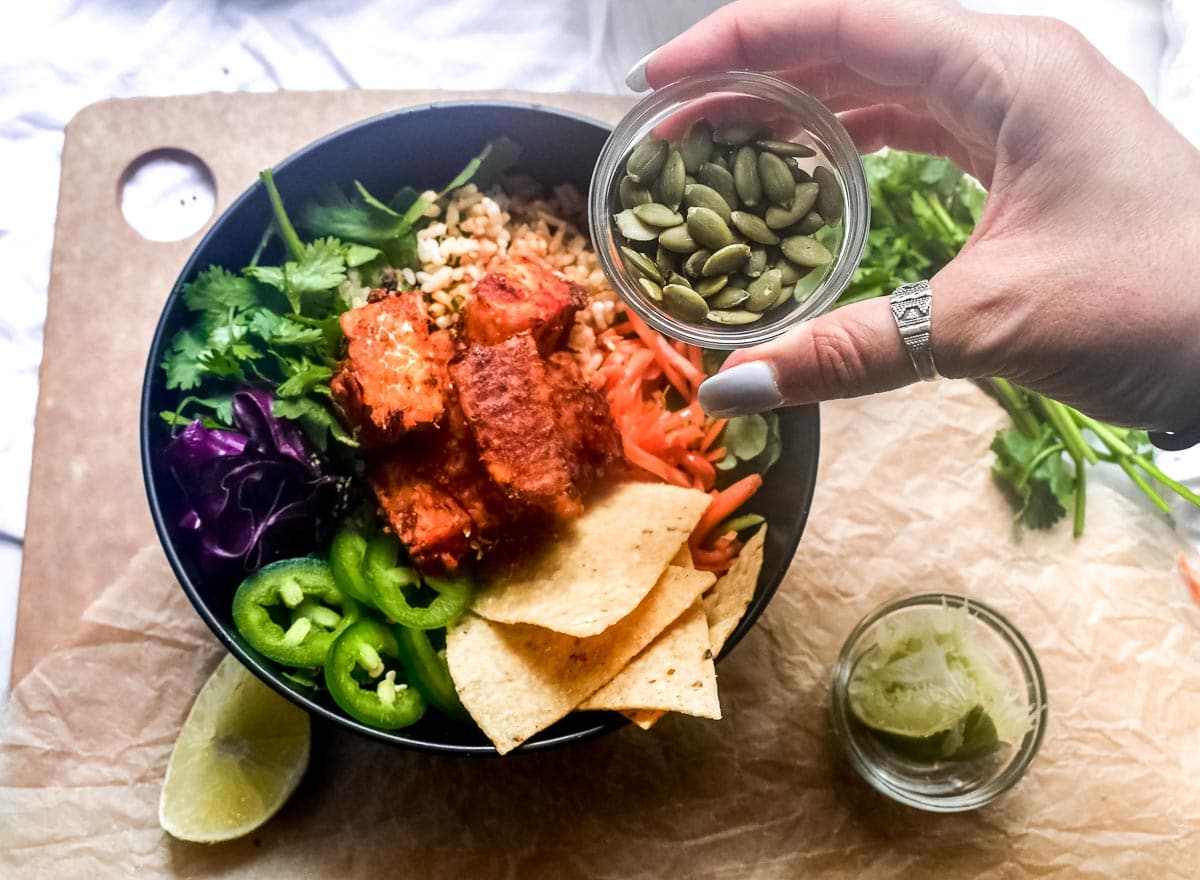
This is a plant-based meal that will thrill your taste buds.
FODMAP Information
Our recipes are based on Monash University and FODMAP Friendly science.
- Arugula: Monash university has lab tested arugula. For many years they stated that arugula had no FODMAPs. After a 2019 smartphone app update, they changed the entry to say that arugula contains trace amounts, but still state, “east freely and according to appetite”.
- Cabbage: Both Monash University and FODMAP Friendly have lab tested various cabbages and reported their low FODMAP serving sizes. According to Monash Green Cabbage is low FODMAP in amounts of 75 g (¾ cup) and Red cabbage is low FODMAP in amounts of 75 g (¾ cup). According to Monash Savoy cabbage is low FODMAP in amounts of 40 g (½ cup). According to FODMAP Friendly Savoy cabbage is low FODMAP in amounts of 75 g (1 cup). According to both Monash and FODMAP Friendly, Napa cabbage is low FODMAP in amounts of 75 g (1 cup).
- Carrots: Carrots have been lab tested and deemed low FODMAP by both Monash University and FODMAP Friendly. According to Monash carrots contain no FODMAPs.
- Garlic-Infused Oil: Make your own Garlic-Infused Oil or buy a commercial equivalent for the easiest way to add garlic flavor to your food. Fructans in garlic are not oil-soluble, so garlic-infused oil is low FODMAP.
- Lime Juice: Monash University has lab tested lime juice and it is low FODMAP in 1 cup (250 g) amounts (double that of lemon juice, as an interesting fact).
- Maple Syrup: Both Monash University and FODMAP Friendly have lab tested maple syrup. Monash says that maple syrup is Green light and low FODMAP in servings of 2 Australian tablespoons (50 g). FODMAP Friendly gives it a “Pass” at 2 tablespoons (53 g). These amounts are likely recommended due to Australian healthy eating guidelines; no upper limit is posted by either Monash or FODMAP Friendly.
- Rice: Between FODMAP Friendly and Monash University, many different kinds of rice have been lab tested and they have low FODMAP amounts. Cooked white rice, according to Monash, is low FODMAP at 1 cup (190 g). Cooked brown rice, according to Monash, is low FODMAP at 1 cup (180 g). Cooked red rice, according to Monash, is low FODMAP at 1 cup (190 g). FODMAP Friendly has lab tested black rice and says a low FODMAP serving is 125 g cooked. Note that this is less than white or brown rice. According to Monash, cooked glutinous rice at 1 cup (190 g) is low FODMAP and cooked basmati rice is low FODMAP at 1 cup (190 g).
Please always refer to the Monash University & FODMAP Friendly smartphone apps for the most up-to-date lab tested information. As always, your tolerance is what counts; please eat accordingly. The ultimate goal of the low FODMAP diet is to eat as broadly as possible, without triggering symptoms, for the healthiest microbiome.
Looking for vegetarian breakfasts? Check out this article, with our favorites.
And for more plant-forward recipes in general, check out Plant Power: 31 Low FODMAP Vegan and Plant-Based Recipes.
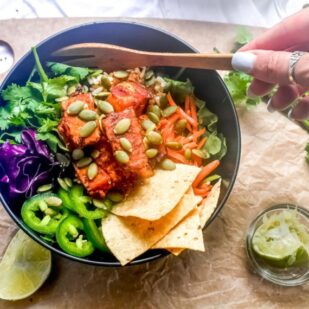
Low FODMAP Baja Tempeh Taco Salad
Our plant-based Low FODMAP Baja Tempeh Taco Salad features spicy, seasoned tempeh as the star of the show, but it doesn’t stop there! In addition to cumin, cayenne, smoked paprika and oregano tempered with maple syrup and soy sauce we have a fresh crunchy salad with arugula, cilantro, cabbage and pepitas. More texture and flavor from nutritional yeast and tortilla chips top everything off with a garlicky lime dressing.
Ingredients:
For Tempeh:
- 7- ounces (200 g) plain tempeh
- 1 tablespoon Garlic-Infused Oil, preferably made with avocado oil
- 2 teaspoon lime juice
- 1 teaspoon ground cumin
- 1 teaspoon low-sodium gluten-free soy sauce
- 1 teaspoon maple syrup
- 1 teaspoon oregano
- 1 teaspoon smoked paprika
- 1/2 teaspoon red pepper flakes
- 1/4 teaspoon cayenne pepper
- 1/4 teaspoon salt
For Salad:
- 2 cups (75 g) arugula
- ½ cup (50 g) shredded carrot
- ½ cup (50 g) shredded red cabbage
- ½ cup (8 g) cilantro leaves
- ½ cup (90 g) cooked brown rice, warm or at room temperature
- About 8 corn tortilla chips, about 50 g
- 2 tablespoon pepitas
- 1 tablespoon nutritional yeast, such as Bragg’s
- Sliced jalapenos
For Dressing:
- 1 tablespoon Garlic-Infused Oil preferably made with avocado oil
- 1 tablespoon lime juice
- Salt
- Freshly ground black pepper
Preparation:
-
For the Tempeh: Preheat your oven to 375°F (190°C). Have ready a parchment lined half-sheet pan.
-
Add about 1-inch (2.5 cm) of water to a medium saucepan fitted with a steamer insert and bring to a boil.
-
While your water is coming to a boil, prepare your tempeh by removing it from the packaging and chop into 1-inch (2.5 cm) cubes.
-
Once your water is boiling, add your tempeh to the steamer and cover. Allow the tempeh to steam for 15 minutes.
-
While the tempeh steams, prep your smokey taco marinade! Combine the lime juice, cumin, soy sauce, maple syrup, oregano, smoked paprika, red pepper flakes, cayenne and salt in a medium bowl and mix well.
-
Remove tempeh from the steamer. You can steam and bake the tempeh ahead of time, if you like. Refrigerate in an airtight container for up to 2 days and bring to room temperature before proceeding.
-
Toss tempeh in a small bowl with oil. Transfer the tempeh onto reserved half-sheet pan, and make sure that the pieces are evenly spaced. Bake tempeh in the oven for 15 minutes or until golden brown, flipping over once during baking.
-
Add tempeh fresh from the oven to the spicy taco marinade bowl and toss to coat.
-
For the Dressing & Salad: As the tempeh bakes, whisk the dressing oil and lime juice together and season with salt and pepper – or for a fancier low FODMAP salad dressing try our Low FODMAP Green Goddess Dressing.
-
Start building your salad buy arranging arugula, carrot, cabbage, cilantro and rice in 2 serving bowls. Add tempeh, chips, pepitas, nutritional yeast (for a cheesy taste) and jalapeno and serve immediately.
Notes:
- You could serve the bowl without the rice, or try another low FODMAP grain, like quinoa.
- Please do not skip the steaming step to prep the tempeh! This step is essential to making the texture softer and less chewy.
- The marinated tempeh is best consumed warm and fresh out of the oven, while still crispy.
FODMAP Information
Our recipes are based on Monash University and FODMAP Friendly science.
• Arugula: Monash university has lab tested arugula. For many years they stated that arugula had no FODMAPs. After a 2019 smartphone app update, they changed the entry to say that arugula contains trace amounts, but still state, “east freely and according to appetite”.
• Cabbage: Both Monash University and FODMAP Friendly have lab tested various cabbages and reported their low FODMAP serving sizes. According to Monash Green Cabbage is low FODMAP in amounts of 75 g (¾ cup) and Red cabbage is low FODMAP in amounts of 75 g (¾ cup). According to Monash Savoy cabbage is low FODMAP in amounts of 40 g (½ cup). According to FODMAP Friendly Savoy cabbage is low FODMAP in amounts of 75 g (1 cup). According to both Monash and FODMAP Friendly, Napa cabbage is low FODMAP in amounts of 75 g (1 cup).
• Carrots: Carrots have been lab tested and deemed low FODMAP by both Monash University and FODMAP Friendly. According to Monash carrots contain no FODMAPs.
• Garlic-Infused Oil: Make your own Garlic-Infused Oil or buy a commercial equivalent for the easiest way to add garlic flavor to your food. Fructans in garlic are not oil-soluble, so garlic-infused oil is low FODMAP.
• Lime Juice: Monash University has lab tested lime juice and it is low FODMAP in 1 cup (250 g) amounts (double that of lemon juice, as an interesting fact).
• Maple Syrup: Both Monash University and FODMAP Friendly have lab tested maple syrup. Monash says that maple syrup is Green light and low FODMAP in servings of 2 Australian tablespoons (50 g). FODMAP Friendly gives it a “Pass” at 2 tablespoons (53 g). These amounts are likely recommended due to Australian healthy eating guidelines; no upper limit is posted by either Monash or FODMAP Friendly.
• Rice: Between FODMAP Friendly and Monash University, many different kinds of rice have been lab tested and they have low FODMAP amounts. Cooked white rice, according to Monash, is low FODMAP at 1 cup (190 g). Cooked brown rice, according to Monash, is low FODMAP at 1 cup (180 g). Cooked red rice, according to Monash, is low FODMAP at 1 cup (190 g). FODMAP Friendly has lab tested black rice and says a low FODMAP serving is 125 g cooked. Note that this is less than white or brown rice. According to Monash, cooked glutinous rice at 1 cup (190 g) is low FODMAP and cooked basmati rice is low FODMAP at 1 cup (190 g).
Please always refer to the Monash University & FODMAP Friendly smartphone apps for the most up-to-date lab tested information. As always, your tolerance is what counts; please eat accordingly. The ultimate goal of the low FODMAP diet is to eat as broadly as possible, without triggering symptoms, for the healthiest microbiome.
Nutrition
All nutritional information is based on third-party calculations and should be considered estimates. Actual nutritional content will vary with brands used, measuring methods, portion sizes and more. For a more detailed explanation, please read our article Understanding The Nutrition Panel Within Our Recipes.
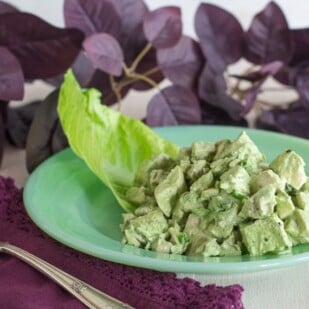
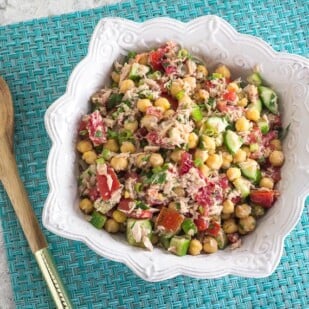






I too was not crazy about tempeh, but that was before I tasted this recipe. Wow! What a great salad! Thank you for this recipe.
We are so happy to hear you loved it! Maybe check out our Tempeh Chili?